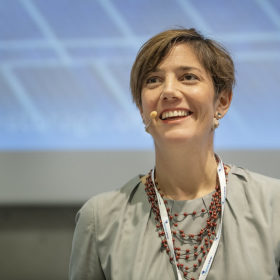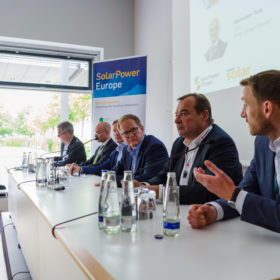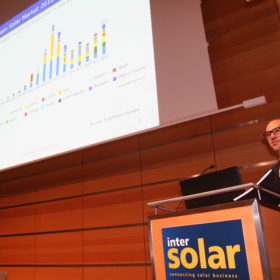The sun rises on a European Green Deal
As the European Commission prepares its strategy for a European Green Deal, it is important to understand how solar can deliver on ambitious climate targets.
Europe on track for decade-topping 16.7 GW of new solar this year
Trade body SolarPower Europe’s preliminary statistics suggest this could be the continent’s best year for PV since 2010, with capacity additions set to soar 104% year on year. Spain is leading the way with an expected 4.7 GW of new solar, followed by Germany, with 4 GW.
Operation Silver Frog: Innovative 2 GW solar production plan for green hydrogen in Europe
European partners have submitted a joint proposal to use EU-made solar modules and wind turbines to power green hydrogen for use by heavy industry. The partners hope to secure designated status and backing from the bloc’s deep coffers.
Pakistan’s Nepra mulls another 50 MW of solar
The country is steadily expanding solar generation capacity as it aims for 5 GW by 2022, helped by an influx of foreign investment from China’s Belt & Road infrastructure program and World Bank capital.
Mini series: Campaigning from rooftops to industrial sites
Walburga Hemetsberger joined SolarPower Europe as its new CEO around six months ago. It’s been a busy time, with the European elections and attempts to implement net zero emissions strategies that have kept Brussels hustling and bustling. At the same time, Europe’s solar industry association has been trying to push its industrial policy and rooftop campaign. Hemetsberger sat down with pv magazine for an update.
BIPV chance for successful energy transition in European cities
With buildings responsible for 36% of EU greenhouse gas emissions and half the bloc’s energy demand, European cities will have to accelerate deployment of renewable energy and foster substantial investment in energy efficiency to become carbon neutral by 2050. A new report has found ‘solar skins’ are well positioned to help achieve that goal and multiply the contribution of rooftop solar.
Solar industry demands new strategy for European PV
Leading representatives of the European solar industry have issued a call for a new industrial strategy ahead of the European Commission’s upcoming proposals for the sector, which are expected this summer.
Get out and vote!
As the European elections approach, it will be vital to have MEPs that are committed to solar and help ensure that the lowest cost and most flexible clean energy technology is the leading contributor to the EU’s 2050 climate strategy, writes Walburga Hemetsberger, CEO of SolarPower Europe.
Intersolar Europe 2019: Europe, Middle East becoming PV growth engines
While China is resetting its policy framework, other regions are gaining more importance on the global PV market. The Intersolar Europe conference in Munich focused on Europe and the Middle East as growth drivers.
Global cumulative PV capacity may reach 1.3 TW in 2023, SolarPower Europe says
The European solar trade body expects 128 GW of new PV capacity in 2019, with China likely to bring around 43 GW online and Europe experiencing enough demand to deploy about 20.4 GW. In 2020, global solar demand is expected to reach 144 GW, while in the following three years new PV additions are forecast to total 158 GW, 169 GW and 180 GW, respectively.










